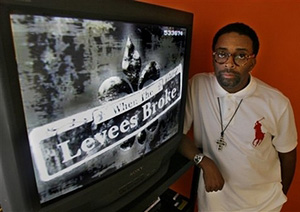 |
 |
 |
 Entertainment | August 2006 Entertainment | August 2006  
Spike Lee Turns Cameras on New Orleans
 Oliver Burkeman - Guardian UK Oliver Burkeman - Guardian UK


| | Hurricane Katrina film gets world premiere. Hailed as most essential work of director Spike Lee's career. |
Film director Spike Lee's long-awaited four-hour documentary about Hurricane Katrina was due to receive its world premiere this week, watched by 16,000 people who lived through the tragedy.

The first half of Lee's $2m (£1.05m) documentary, When the Levees Broke: a Requiem in Four Acts, was scheduled to be shown to a sell-out audience in the New Orleans Arena. The venue is next door to the Superdome, the sports complex where more than 15,000 people sought shelter during the hurricane last year.

"What we hope with this piece is that it brings attention back to New Orleans, back to the other gulf states that are still dealing and struggling with the ravages of Hurricane Katrina," the director, 49, told the New Orleans Times-Picayune newspaper. "A lot of Americans are saying, 'That was so last year. I'm on to the next thing. C'mon, you're killing us with this Katrina thing.' Well, I'm sorry. People are still struggling, and ... will be dealing with the aftermath for years."

The film's opening sequence begins by interspersing archive footage of parties and parades in New Orleans with pictures of debris and bodies floating in the floodwater. The rest is given over to the direct testimony of angry and devastated local residents, officials and some of the celebrities who came to the city to help, including the actor Sean Penn and the hip-hop artist Kanye West.

It will be shown on US television twice in the coming weeks, once in two parts, and once as a whole on August 29, the first anniversary of the night the storm hit land. By the end of the crisis, at least 1,836 people had died; thousands more remain displaced.

The economic aftermath continues: this week, in a judgment that could set a precedent for hundreds of insurance claims, a court ruled that an insurance firm offering payouts for wind damage was not required to pay for water damage, even when high winds were the cause.

Calling the movie "arguably the most essential work of [Lee's] 20-year career", Newsweek said audiences might be surprised that the director, who made his name with a series of feature films addressing racial politics, "views the tragedy as a national betrayal rooted in class, not skin colour. To him, what the victimised share most is that they had very little to begin with and were left with nothing."

But the Times-Picayune disagreed. "The tragic story of black New Orleans trapped in Katrina's path has found a supreme chronicler," its reviewer wrote. "But the flooded-out residents of [predominantly white neighbourhoods] Lakeview or Old Metairie who attend [the premiere] will spend all night sitting on a hard plastic chair and then wonder: Where am I in this?"

In interviews, and in the documentary, Lee refused to reject the belief, held by many black residents, that the government bombed the levees, flooding the poorest areas to spare the wealthiest ones, such as the French Quarter, which is the biggest draw for tourists. "We let people say what they think," he said, noting the government did destroy levees during the 1927 Great Flood of Mississippi. "We have people from the Lower Ninth Ward who swear on a stack of Bibles they heard explosions. We have scientists say that it wasn't explosions, that they heard water going through a levee."

He told CNN: "I don't put anything past the US government. I don't find it too far-fetched that they tried to displace all the black people out of New Orleans."

The main culprits to emerge from the documentary are the Army Corps of Engineers, for how they built the levees, and the Federal Emergency Management Agency, for how it mishandled the crisis. | 
 | |
 |



